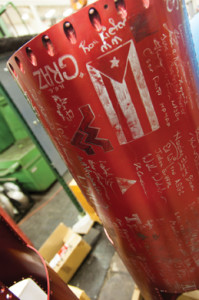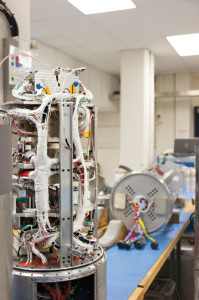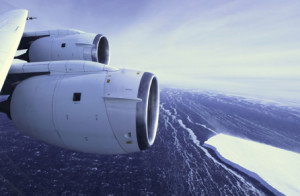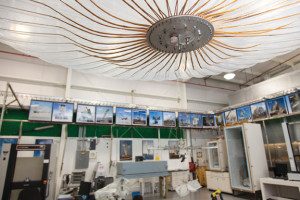By Kensie Hamilton Fauber
Upon hearing NASA, the acronym for the National Aeronautics and Space Administration, most people immediately think of the International Space Station (ISS), astronauts and probably Tom Hanks’ role in the movie “Apollo 13.” While those are all fair interpretations, it is important to understand that NASA is so much more than rockets and movie sets. In addition to space exploration and research, one of NASA’s main points of interest is education, and the organization offers educational opportunities that begin with children in grade school and continue through high school and college.
“Education is a fundamental part of NASA’s work to execute its vision to reach for new heights and reveal the unknown so that what we do and learn benefits all humankind,” says Joyce Winterton, senior advisor for Education and Leadership Development at NASA’s Wallops Flight Facility (WFF) on Virginia’s eastern shore. “One of NASA’s strategic objectives is to advance the nation’s science, technology, engineering and mathematics (STEM) education and work force pipeline. The agency is supporting our nation’s elementary and secondary schools, universities, colleges and community colleges by providing exciting research, authentic experiences and internship opportunities that will light the fire and fuel the passion for a new culture of learning and achievement in STEM education.”
NASA’s focus on education has led to a more broad-based method for research and development. Many of the experiments and testing NASA conducts take place on the ISS, as well as aboard smaller rockets, and NASA also has aviation and balloon departments that allow a less expensive medium for research.
NASA in West Virginia
The research NASA conducts stretches across the globe, some of which is done in a facility right here in the Mountain State. The NASA Independent Verification and Validation (IV&V) Facility is located in the I-79 Technology Park in Fairmont. The IV&V Program was created in 1993 as a way for the entire agency to manage the software components of NASA missions.
“IV&V identifies a wide variety of software-related issues, including failure to test critical scenarios, incorrect requirements for essential functionality and lack of system interface definition,” says Jeffrey Northey, NASA’s IV&V Program strategic communications lead. “These issues can have the potential to result in loss of science data, loss of communication with the spacecraft, complete loss of the mission or injury to people.”

The reusable exterior of the payload that flies inside a sounding rocket.
The goals of safety and mission success are at the forefront every day for the 200 West Virginians who work at Fairmont’s IV&V Facility. This dynamic group of employees is made up of a variety of engineers, software scientists, information technology professionals, accountants, program analysts, project managers, program managers, communications specialists, educational outreach specialists and, of course, interns.
“NASA’s presence in West Virginia is a rather broad base of project interaction and is more technical in nature as opposed to physical,” says Jennifer Neptune, a program analyst for NASA’s IV&V Program. “For the most part, we don’t build things here. We will do small-scale initiatives that help our engineers understand the larger concepts on major NASA project initiatives. Our day-to-day work may appear rather boring to the average observer, but it actually makes a big difference in the overall safety and reliability of major NASA missions. The work done here makes a difference for NASA, as well as the state.”
To continue the NASA focus on education, the IV&V Facility works with students and teachers across West Virginia. “Annually, our team impacts approximately 5,000 students and teachers, maximizing partnerships with West Virginia industries, government institutions at all levels, higher education institutions, community organizations and extra-curricular, STEM-focused groups like robotics and aviation teams,” says Neptune. This education outreach affects students of all ages and creates internship opportunities.
Flights in Exploration
In the field of space exploration, not all rockets are created equal. Take NASA’s Sounding Rockets Program Office (SRPO) at the Wallops Flight Facility for example. Depending on the payload, flight plan and mission, the SRPO has 15 different types of sounding rockets to choose from that they will launch for universities and government agencies. There are usually 20 suborbital mission launches each year from the United States, Norway and Sweden. Since sounding rockets are smaller and more portable, it is also possible to have a mobile setup. In the past, NASA has had mobile launches from Australia, Puerto Rico, Brazil and Kwajalein Atoll.
“One of the advantages of sounding rockets is that they allow scientists to use and test new technologies,” says Keith Koehler, who works in the Office of Communications at NASA’s WFF. “Sounding rockets have a quick turnaround in the scientific building world. It usually only takes one to two years from the time we start to the time they are launched. This allows us to use sounding rockets as a great educational tool for students, whether it be learning how to build rockets or learning how to build the actual instrumentation that flies on the sounding rockets to conduct science.”

A payload during testing to ensure it will survive the launch and mission.
Before a payload is launched, it must undergo extreme testing to ensure it will survive the mission. This requires vibration testing, bend testing and spin testing. Each payload is also carefully measured to ensure the rocket will perform as desired based on weight and its center of gravity. Each rocket’s payload must also be carefully balanced before takeoff. Another benefit of the sounding rockets is that everything in the payload section is reusable. In most cases, using GPS tracking allows NASA to retrieve the payload section for reuse, which also helps keep the cost down.
To create these rockets and payloads, NASA has a large machine shop that makes it possible to build the custom pieces. The shop has a variety of milling machines, lathes, welders and sheet metal capabilities, and the students and interns who participate in programs with NASA are involved in every step of the process.
Two of these programs are RockOn!, a five-day workshop, and RockSat, a long-term, fall-to-spring program. Both programs are hands-on workshops for university students and faculty to create a payload experiment to fly onboard a sounding rocket. West Virginia University (WVU) is one of many universities to participate in these programs.
“RockSat has been a great, hands-on science and engineering project in which we have participated annually since 2009,” says Dimitris Vassiliadis, a research associate professor in WVU’s Department of Physics and Astronomy. “For our physics and aerospace students, participating in spaceflight projects provides a good challenge in carefully building a compelling experiment that can meet the requirements of a NASA flight. As part of this challenge, students learn to work in a team, develop leadership skills and present their recent work and future plans to the flight managers. During this process, students interact regularly with WFF staff via teleconferences and other information exchanges. In this way, they get a glimpse of some of the workings inside the nation’s space agency.”
Aviation Education
While NASA is well known for its rockets, there is a great deal of research obtained from the Aircraft Office at the Wallops Flight Facility. The Aircraft Office operates numerous aircrafts that fly all over the world to gather data. Currently, NASA owns and operates four C-23 Sherpas, a P-3B Orion, a C-130 Hercules, a King Air and a UH-1 Huey.

NASA’s DC-8 research aircraft will be flying scientists and instruments over Antarctica to study changes in the continent’s ice sheet, glaciers and sea ice.
Aviation is a cost-effective way for NASA to continue the exploration and education it is so passionate about. One of the recent projects NASA has been working on is IceBridge, an ice mapping mission in the Arctic and Antarctic. To study the summer sea ice melting, the Arctic Radiation IceBridge Sea and Ice Experiment (ARISE) mission conducted mapping flights from August 28 through October 3.
ARISE flew the C-130 for one week at Thule Air Base in northern Greenland and conducted research from Eielson Air Base in Fairbanks, Alaska for the remaining time. This mission is studying how the changes in the clouds affect the sea ice and global warming. The C-130 is equipped with unique instruments that helped gather data for the ARISE team to study and better understand how low-level clouds verses higher clouds affect the heat and radiation levels that melt the sea ice.
The WFF is also involved with unmanned aircraft systems (UAS). Due to the increased popularity of the UAS, NASA’s UAS Integration Department has been tasked, along with the National Airspace System (NAS), with how to safely integrate UAS into the NAS. This crucial project is so important because of what the unmanned aircraft systems have to offer. According to NASA’s Web site, “The application of unmanned aircraft to perform environmental and wildlife monitoring, atmospheric sampling, data collection for weather prediction, agricultural surveying, national security, defense, scientific and emergency management is driving the critical need for less restrictive access by UAS to the NAS.”
Up and Away
A unique part of what NASA does to gather data and educate students is the Balloon Program. This program is also a suborbital space flight program that carries payloads in a very cost-effective manner. The method and technology used to create these enormous balloons is one of a kind. What makes the balloons so incredible is that they are made of 0.8 millimeter-thick polyethylene film, which is similar to the thickness of a sandwich bag. To create a balloon this large, it requires 20 acres of film that, when fully inflated, is 460 feet in diameter and 396 feet in height. Each balloon is launched with a payload and parachute. The balloons can carry up to 8,000 pounds at 120,000 feet but can reach a higher altitude with a lighter payload.

The bottom of a balloon used by NASA to conduct suborbital research.
On average, NASA flies 20 balloons each year, and the flights last anywhere from six to 36 hours to upwards of several weeks. Once the balloon is launched and filled completely with helium, the experiments on board commence gathering data. When the experiments are complete, radio command can create a tear in the film and deploy the parachute, allowing the balloon and payload to float back to the Earth’s surface.
Balloons are one of the most cost-effective ways to explore our environment and space and have been used to do so since the inception of the program in 1982. A large part of the education NASA conducts with students and universities is through the Balloon Program.
“The NASA Balloon Program is a world-class organization responsible for high-altitude flights in polar regions and many other locations on Earth,” says Vassiliadis. “In 2013, in collaboration with NASA’s Sounding Rockets Program Office and other NASA organizations, they put together a new program called the Undergraduate Student Instrument Project, where STEM students compete to construct payloads for rockets, balloons and aircraft. The WVU team was selected to fly a sounding rocket and high-altitude balloon. The two vehicles would fly simultaneously and at nearby locations with the intent to measure the properties of the atmosphere/ionosphere system such as energetic electron flux and magnetic field intensity at two very different altitudes: 30 kilometers, the equivalent of 18.5 miles, and 120 kilometers, or 85 miles. Comparison of these measurements gives students a view of how similar processes operate at different regions of the atmospheric/space environment and a glimpse of the close coupling of the different regions of this complex system.”
As is made evident through their rockets, balloons and other experimental projects, NASA has a unique opportunity to explore our environment and instill a love of learning in students involved with their many exploratory programs. “The big picture of what NASA brings to the community is inspiration,” says Neptune. “The more we can inspire future generations in STEM fields, the more likely we are to achieve the agency’s vision and mission.”



